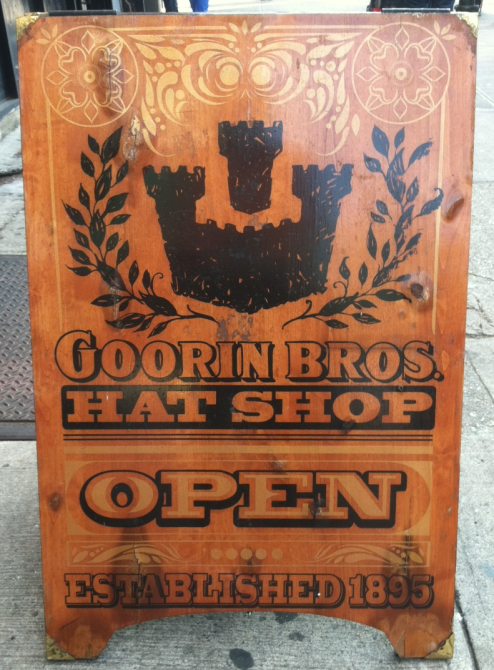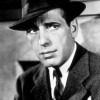
Founded in 1895 but not locally. There are more than two dozen stores in the US and two in Canada. (Large photo: Brooklyn Artisan Photo Pool)
WHAT COLOR WAS BOGEY’S FEDORA?  Tough question. Brown? Gray? I’ve always envisioned Humphrey Bogart wearing a brown fedora in any of his fedora-wearing good-guy movies like Casablanca. The movie was released in black-and-white, but in the scandalously colorized version from the ‘80s his suit is muddy brown, Ingrid Bergman’s silky dress is muddy yellow, and so is Bogey’s pocket square. The characters’ faces are muddy pink. Except Sam, the piano player. So that’s no help.
Tough question. Brown? Gray? I’ve always envisioned Humphrey Bogart wearing a brown fedora in any of his fedora-wearing good-guy movies like Casablanca. The movie was released in black-and-white, but in the scandalously colorized version from the ‘80s his suit is muddy brown, Ingrid Bergman’s silky dress is muddy yellow, and so is Bogey’s pocket square. The characters’ faces are muddy pink. Except Sam, the piano player. So that’s no help.
If anyone knows, it would be the Goorin Bros.
Goorin Bros. is pronounced like Gorn, that sluggish green lizard man that Captain Kirk battles to the death in Star Trek, the original series. The Brooklyn store at 195 Fifth Avenue isn’t like the team cap wall at your local Modell’s sporting goods, or the cheapo hat pile at the open-air bodega up the avenue, the place where you can buy an emergency stocking cap or a cheapo stingy-brim Justin Timberlake knockoff fedora resting in a pile on a folding table, all colors and patterns, in all sizes from small, medium, large, and X-large. This is a real hat shop, with expansive plate-glass windows with Goorin Bros. Est. 1895 in gold-leaf lettering, and shelves inside brimming (Get it? Brimming?) with hats. Though the store has just opened for the day, it’s already brimming (Again! Hah!) with customers. In front, helping a couple, assistant shopkeeper Nicky Culter, wears a Homestead Grays baseball cap sideways while showing a customer straw boaters, perfect for the summer season. In back, near the cash register, shopkeeper Alex Mroz finishes ringing up three others. He wears a Mahi Mahi, a light brown straw fedora that goes with his sharp suit.
”Why do you keep your hat on indoors?” I ask him straight off. It’s an insulting question, but my dad used to slap my head when I wore my baseball cap at the dinner table.
“This is a hat store. People expect it,” Mroz says. “Or I just tell people I’m religious.” After all, Goorin Bros. does carry black fedoras for the Hasidic set.
While baseball caps are always fashionable, felt hats began dying off in the late 60s as men grew their hair longer and stopped slathering it with Brylcreem. But lately real hats have begun a resurgence. You see bowlers, fedoras, even the occasional boater on the streets of Brooklyn or in the subways or buses. Like everything, you want to point to television; personally, I attribute it to Mad Men. And Justin Timberlake.
“There are a lot of cultural emotions going on. Not only Mad Men, but Boardwalk Empire and Downton Abbey,” Mroz says. “It’s partly the neighborhood,” he adds. People here have so much style.”
I tell him that I’m looking for a brown Bogey fedora, vintage Casablanca or The Big Sleep. He says they don’t have any in brown, but offers a gray fedora, the type Bogey wears when he plays the villain, like The Roaring Twenties. I try one on, but I need a double-breasted suit and a gat (that’s 30’s gangster-speak for a revolver) to pull it off.
Mroz thinks I might be interested in something with a narrower brim, a “stingy brim” measuring between an inch and an inch and three-quarters. After all, they have a wide selection. Again, I think Timberlake.
“You can just imagine Sinatra wearing one, hanging at the Sands with Dino and Sammy,” he says. “Sinatra is one of our hat heroes.” And no doubt: There’s a picture of Sinatra, with a feather stuck in his hat band. Which reminds Mroz: “We have a Feather Bar, where you can customize you hat to make a unique statement,” he says.
You get this guy talking about hats and there’s no stopping him. “This is a genuine panama hat, woven in Ecuador,” he turns to the display on a middle table and searches for my size and fits it on my head. Nah. I’m not the cigar smoking type.
I discover a stack on the shelf. “Now this looks like one Buster Keaton wore in his movies,” I say.
“It’s called The Buster. Keaton used to make his own hats.” Talk about small-batch artisanal. Except for the band, The Buster is barely discernable from the one Harold Lloyd wore while hanging off a clock in Safety Last.
“It’s a classic men’s summer hat—men wore them with the bands in their school colors,” he explains. And there’s a framed photo of a crowd of young men, apparently well dressed college men, though all you can really see is the tops of their straw boaters.
Goorin’s is not just about men’s hats: There are women’s in all shapes and sizes, the types that gals would wear in the Easter Parade on the Avenue, Fifth Avenue, when a photographer would snap them and they’d find themselves in the rotogravure. There are cloches and pillboxes, though nothing outrageously weird that Princesses Eugenie and Beatrice wore to Wills and Kate’s wedding.
Still, it’s a store where guys are happy to shop. There are top hats like Lincoln wore, though his measured a foot and a half high. Here they’re around half that height. And plenty of flat caps, which started as aristocracy wear, when the landed gentry would ride off with their shotguns and dogs chasing some poor fox. It usually ended badly for the fox. Within a few years they were co-opted by the city’s lower classes, like cabbies and newsies. Maybe flat caps should be renamed “The foxes revenge.”
Mroz shows me one last hat, a dark, wide-brimmed porkpie. “In Breaking Bad, Walter White wears one to be intimidating when he’s trying to collect money,” he says. I put it on and just look goofy. “You have to wear it with gusto,” he says.
No matter whether I have gusto or not, the prices are pretty reasonable. The lowest is $21, and handmades start at $79.
Handmade? That’s why I ordered a handcrafted brown fedora, just like Bogey wore in Casablanca. It’ll probably go great with my blue jeans, running shoes, and my Steely Dan t-shirt.
Executive Editor Phil Scott is the author of seven books and numerous magazine articles on travel, aviation, science, humor and brain health. He is teaching a journalism class at John Jay High School in Brooklyn.


















[…] Phil Scott is an executive editor of Brooklyn Artisan, a former managing editor of Omni magazine, and the author of seven books, mostly about the history of aviation. He lives in Rockaway. […]
LikeLike